Knots and crossing numbers
A knot is a simple, closed, non-self-intersecting curve in \(R^3\). It is natural to think of a knot as constructed from a string glued together at the ends, usually tangled in the middle.The knot for my project is knot 9-1 in the knot atlas, which is centrosymmetric. The crossing number of the knot is 9. It is common to use a knot diagram or 2D projection to graphically represent knots. A knot is represented by a curved line on the page. When the knot passes under itself, a gap is used at the crossing. The projection of the 9-1 knot is shown in the following picture:
Sequence of crossing switches for unknotting
There are three types of simple allowed ways to deform knot diagrams by changing the number of crossings as shown in the following picture. The unknotting number of a knot is the minimum number of times to switch the crossing points to untie it. The 9-1 knot has the unknotting number \(4\). As shown in the following picture, the sequence of crossings \(1,3,5,7\) marked by red dashed line circles can be switched, then by using the Type II and Type I deforming methods, the knot is untied.Coloring the knot
The 9-1 knot is colorable under the following rules for coloring a crossing- all three colors are used; or
- only one color is used.










Comments
Post a Comment